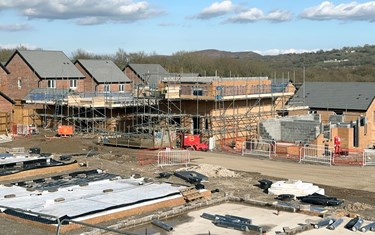On 9 February 2024, Dr Caroline Brown (Director of RTPI Scotland, Ireland, and English Regions) gave written evidence to the Scottish Parliament's Local Government, Housing and Planning Committee inquiry into Housing to 2040. This was followed up by verbal evidence on 27 February.
Read the written evidence in HTML format below or in PDF format here.
You can watch the Local Government, Housing and Planning Commitee Meeting that took place on 27 February 2024 here.
About the RTPI
The Royal Town Planning Institute (RTPI) is the professional body representing the planning system and planning professionals in the UK and internationally and has more than 27000 members worldwide. The Institute champions the power of planning to create sustainable, prosperous places and vibrant communities. As a learned society, we use our expertise and research to bring evidence and thought leadership to shape planning policies and thinking.
Overview
RTPI Scotland welcomes this opportunity to discuss ‘Housing to 2040’ with the Committee. The key aim of Housing to 2040 is “for everyone to have a safe, high-quality home that is affordable and meets their needs in the place they want to be”. The Institute supports this aim, and advocates for positive planning and placemaking that delivers good quality housing in sustainable communities.
We are acutely aware of the challenges around housing delivery across Scotland and have prepared this submission with the input of members in both the public and private sector. Our focus here is on the role of planning, but we acknowledge that housing delivery is the product of interactions between the planning system; housing finance; market demand; development viability; regulation of short-term lets; building standards and rent controls.
RTPI Evidence to the Committee
Q1. Are we building enough homes or bringing enough homes back into use to meet Scotland’s current and future housing needs?
It’s clear that we are not building enough homes, and there is plenty of evidence about the size and scale of the deficit. The recent declaration of housing emergencies in Edinburgh, Glasgow and Argyll & Bute demonstrates very acute housing problems in some places.
However, it’s important to understand that the factors contributing to the housing shortfall vary significantly across Scotland. Context is important. Our members have told us that in some parts of Scotland there is little prospect of private sector housing being built, because there is insufficient profit for housebuilders. In these communities, land is available for housing but the private sector is not interested, so the public sector and RSLs are the key to delivery. In some cases, the effects are very localised, with Drumchapel housing land for example, of little interest to developers compared to sites in nearby Bearsden.
In other parts of Scotland demand is high but land may be constrained. Edinburgh is the most extreme example, with high demand for housing combining with pressures from short-term lets, student accommodation and commercial development pushing up land values, prices, and rents. Some rural and island communities are also affected by high demand (e.g. for second homes) and acute affordability issues for local people.
Another barrier to housing delivery includes the availability of data on the suitability of land for housing. Scotland has a considerable legacy of vacant and derelict land – not all of this is in appropriate locations for new housing, and not all of the land in appropriate locations is usable. Our members have said that they do not have access to data about the fitness of vacant sites for development to help them understand which land to allocate in their development plans. Contamination may require short or long-term remediation and some sites may only be suitable for redevelopment after several years of treatment.
On future housing needs, our members are not convinced that we have a good handle on the impact of changing demographics on housing needs and design. Enabling ageing in place, for example, means ensuring that older residents can find appropriate housing within their communities and are not forced to move away. This needs to be reflected in the diversity and type of housing built in new developments, and in the management of housing stock over time. This might mean thinking through policies around dormer conversions, for example, where this undermines the supply of smaller bungalows within a community.
Q2. Are we building homes with a focus on placemaking?
The response from our members to this question was: it is still relatively early days.
The place principle is now well established in Scottish policy and supported by NPF4. In terms of legislation and policy our members say that the guidance is in place – but local authorities need adequate resources and skills to promote and support place-making approaches.
Our latest analysis of data about planning resources in Scotland shows a very challenging situation, with the public sector workforce at the lowest level in five years. There were 1205 members of staff in local authorities as of 2022/23. The previous year’s level was 1242.
RTPI Scotland’s 2022 update reported that the Planning (Scotland) Act 2019 introduced 49 unfunded duties on local authorities. The Scottish Government’s roll out of this legislation risks planners (and the planning system) being immediately placed on the back foot in terms of delivering on these duties without a robust resourcing and upskilling strategy in place.
RTPI | Resourcing the Planning Service (RTPI Scotland Research briefing) December 2023
It takes time, skill, and effort to bring elected members and developers on board with place-making approaches. There can be push back from the private sector concerned about profits – but several authorities have shown that it is possible to work with developers to improve the quality of the housing schemes that are put forward. This cannot happen overnight and requires sustained effort over time.
There are some promising signs on this, but it’s a work in progress, and some authorities further on in the journey than others.
Q3. Are we creating and sustaining a mix of housing that is financially and physically accessible to all?
Our members also think that this is a mixed picture.
NPF4 policies mean that it is easier for local authorities to get the right schemes in the right places, helping with accessibility of new housing to active travel and public transport networks. Physical accessibility is also enhanced through place-making approaches. However, there is also a legacy of existing development which is poorly located, and which need interventions to overcome the transport poverty that they experience.
On housing mix, planning policy and NPF4 are clear on affordable housing requirements in new housing developments. However, the declared housing emergencies demonstrate that there is a very significant affordability problem. The planning system cannot resolve all of these issues.
Q4. Are we building homes and retrofitting existing homes to provide for affordable warmth and zero emissions?
Our members tell us that new housing – particularly those in the social sector – is being built to high standards. However, there are financial challenges in the delivery of Passive House standards because higher build costs are not offset by additional funding from the Scottish Government. In addition, some RSLs are finding maintenance costs may increase for these homes because tenants make inappropriate modifications to their homes.
On broader retrofit programmes, our members think that there is a role for planning to consider the characteristics and quality of local housing stock alongside analysis of neighbourhoods (e.g. streets, greenspace, accessibility) to identify communities where there is potential for interventions such as district heating, community energy schemes or group repair.
Finally, members report that planning and building standards are not aligned and can work against each other. For example, one member described the way in which the redevelopment of historic buildings can be badly affected by building standards cutting across planning objectives.
These tensions can be resolved through collaborative working, bringing building standards officers on board early in the conversation about new development. However, this requires time and resource upfront – and there is not always the capacity or resource to make that happen reiterating the point about adequate resourcing within local authorities.
Q5. Are we ensuring that new and existing homes are safe and of a high quality?
Creating and maintaining safe, high-quality places is a central purpose of planning. This is supported by NPF4, the place principle, 20-minute neighbourhoods, local place plans and place making approaches. However, as noted above (Q2) achieving this in practice requires there to be sufficient resources at local authority level. A stretched planning authority will not be able to support place-making approaches in tandem with developers and other stakeholders.
Concluding Comments
NPF4 provides planning authorities and practitioners with a stronger set of policies that guide new development, getting housing into the right locations, considering places and neighbourhoods and not just units of housing. Place making and high-quality development now have greater priority, but require skills and resources.
It will take time for these policies to have a tangible effect on Scottish housing stock, and there is a need for interventions to retrofit existing housing stock and shape neighbourhoods as they develop and mature. We need to think through future housing needs so that we maintain diverse types and forms of housing within communities, supporting ageing in place.
Finally, the factors affecting housing delivery across Scotland are very variable, and there is no single explanation for the housing shortfall. Capacity and bottlenecks in the planning system are a factor, but these are a reflection of the constraints in public sector planning resources. Working with building standards, conservation, transport, green infrastructure, housebuilders, RSLs and other stakeholders to deliver high quality, safe and inclusive communities require sufficient staff, sufficient skills and sufficient time.
Appendix: Housing to 2040 consultation response
In February 2020, RTPI Scotland responded to the Scottish Government’s consultation on the draft Housing to 2040 strategy. In our response we made the following key points:
Infrastructure
- We need to be clear on who pays for infrastructure and what constitutes effective land to ensure the right housing developments can be delivered.
- Long-term development of Scotland’s transport infrastructure cannot be viewed in isolation from related land use planning consideration. It is crucial to align transport infrastructure and housing delivery more effectively.
- Connectivity for communities is important, especially by encouraging active transport. Planners need the knowledge, skill, and experience to define and control strategic infrastructure, recognise what makes an effective street composition, encourage the right mix of uses, house types and tenures and how these integrate to make great places.
Delivering Quality Homes
- Housing discussion can often be preoccupied with discussion on numbers and the need for speedy delivery that tackles shortages of supply. It is important that we don’t lose sight of the importance of quality of development and its contribution to promoting high quality, economically, socially and environmentally sustainable settlements.
- RTPI Scotland believes that the Scottish Government must take a more active role to increase the number of quality homes built through:
- prioritising its Capital Borrowing Powers to fund housing and infrastructure
- establishing a body or number of special purpose vehicles to work with local partners to coordinate and front load infrastructure, deliver development, and assemble land across Scotland
- the new NPF4, which should include the number of houses to be built in a specific time period with details of the tenure mix including provision of affordable housing in line with Local Development Plans and Strategic Housing Investment Programmes (SHIPs). The National Planning Framework, Strategic Development Plans and City Deals can integrate infrastructure to support existing and new development.
- strategic allocations need to be tied in with Scottish Government’s Infrastructure Investment Plan.
The Place Principle and Place-making
- Too many policy approaches and funding decisions are uncoordinated and do not consider the impact they have on communities as well as individuals. The Place Principle provides a welcome focus on breaking down silo working, which RTPI Scotland believes could make a significant contribution to better placemaking.
- Planning and placemaking should be viewed as 'preventative spend': Upfront investment in places that ultimately deliver better outcomes for public health and wellbeing, the environment, and the economy. A tangible outcome from a place-based approach would be close alignment of development plans, community plans, Single Outcome Agreements, investment plans, locality planning, and infrastructure delivery. Whether it is carried out at the pre-application stage or after an application has been lodged, Design Review Panels enable local planning authorities to ensure that developers and design teams produce high-quality, inspiring buildings and outstanding and innovative design, supports them in resisting poor design and gives them a practical means of understanding where improvements need to be made.
- Scottish Government needs to take opportunities to coordinate communities’ engagement in processes which shape their places and to get more people involved, for example through the Place Standard, which is proven as an effective tool for the engagement of a broad cross section of society including of seldom heard groups and young people in both community and development planning.
Planners and Resourcing
- Planning needs to be involved with corporate decision making in local authorities to ensure joined up strategies and investment plans to deliver more housing. For example, tying in educational catchment planning with developer contribution towards education resulting from new developments. RTPI Scotland welcomes the provision for mandatory Chief Planning Officers in local authorities included in the Planning (Scotland) Act 2019.
- We need to allow planners to plan for the best and most sustainable locations for housing and make sure we don’t go down the expensive and time-consuming route of planning by appeal.
- It is important to invest in the next generation of those who will make housing happen, including planners. Local authority planning departments have suffered disproportionately from funding cuts since 2010.
- Ensure that existing planning policy levers are made best use of: Scottish Planning Policy states that “the planning system should identify a generous supply of land for each housing market area...maintaining at least a five year supply of effective housing land at all times”. It should be informed by a robust housing need and demand assessment (HNDA). As part of the HNDA, “local authorities are required to consider the need for specialist provision that covers accessible and adapted housing, wheelchair housing and supported accommodation, including care homes and sheltered housing. This supports independent living for elderly people and those with a disability. The HNDA should include a detailed survey and analysis of older people, their housing tenure, population projections and a breakdown of older people’s disabilities.
Urban Form
- Urban form is a critical consideration: Compact, medium density, mixed use and public-transport friendly settlements encourage continued physical activity, economic participation, and social interaction into old age. To realise these benefits, efforts are needed to make towns and cities age-friendly, including the provision of more appropriate and specialist housing.
- Settlement patterns and urban forms that promote sustainable mobility can play a critical role in reducing emissions from the transport sector, where decarbonisation is urgently needed. Evidence shows that larger settlements, with higher densities and mixed land use, can increase levels of self-containment and reduce the need to travel by car. Studies suggest a positive correlation between higher densities and lower emissions, with medium- rise developments in existing urban areas consuming the least energy. Heating and hot water for buildings made up 40% of UK energy consumption and accounted for 20% of greenhouse gas emissions. Heat networks will be a key component of reducing this area of emissions due to the costs of constructing and laying pipes and the need to balance supply and demand, urban heat networks are best suited to higher density mixed developments.
Small Scale Sites
- Incentives should be created for developers to deliver on smaller parcels of land allocated in local development plans. An example of such an initiative can be found in Edinburgh’s Small Site Affordable Housing Program. Opportunities to review investment tied up in roads bonds should be considered as a means of attracting smaller scale developers who may not have sufficient capital to deliver a site without financial assistance.


